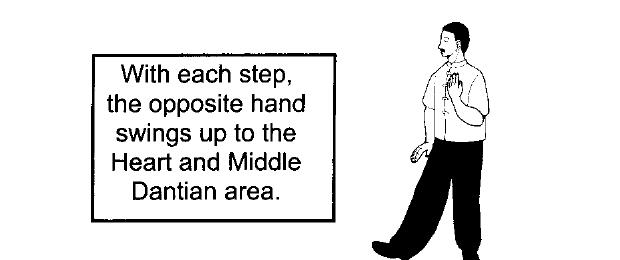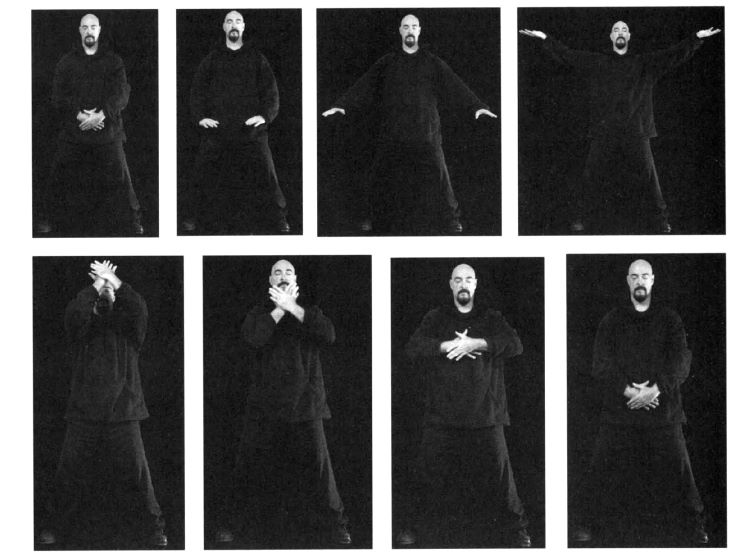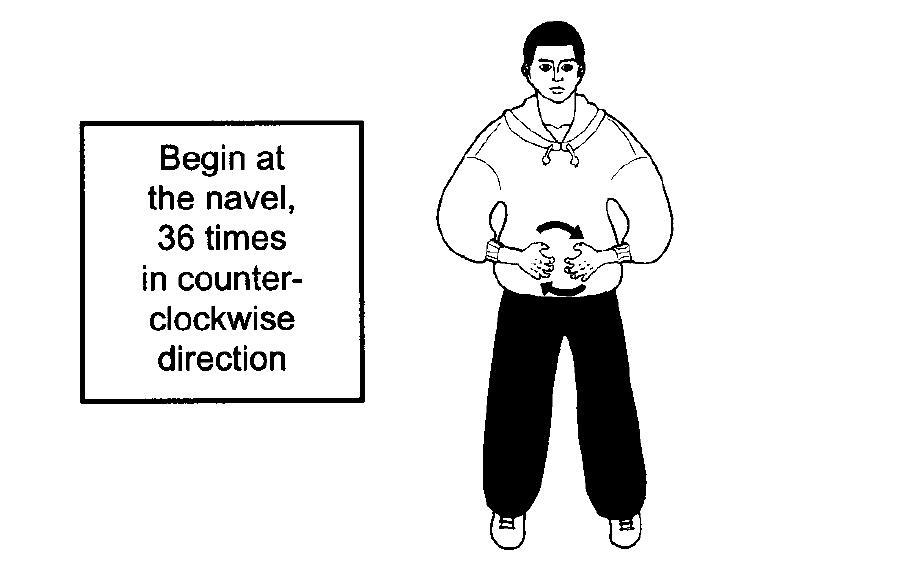WALKING THERAPY EXERCISES
The Fast Walking Method stimulates the electromagnetic fields within the tissues and reinforces the patient’s Yuan Qi. By walking fast and changing their normal breathing patterns, the cancer cells can be more easily destroyed. The dual action shocks the system because more Qi and blood flowing through the body stimulate the electromagnetic fields within the tissues, stimulating the cells and the immune system.
These supplementary Medical Qigong Walking exercises are given to cancer patients for breath regulation and Qi reinforcement. The breathing methods are applied with dynamic regulation walking therapy. The regulation walking methods use the “exhaling method” to strengthen the kidneys, increase oxygen intake, and enhance the immune system.

THE THREE-STEPPING METHODS USED TO TREAT CANCER
The stepping methods are performed at three different speeds, depending on the patient’s symptoms. The patient is encouraged to walk at least once a day for 15–20 minutes. These walking exercises are classified into three kinds of prescriptions according to the following breathing rates:.
THE FAST-WALKING METHOD
The Fast Walking Method is mainly prescribed for patients in the early stages of cancer and is especially suitable for patients with Lung cancer. This exercise is practiced using even breathing, inhaling for one step, followed by exhaling for another step. The patient steps forward with the left foot while inhaling through the nose. They then step forward with the right foot and exhale through the nose.
Both hands swing naturally up to the chest while walking. The main point to remember while stepping is that the head leads the waist in turning and swinging the arms. The rate of speed should be 60–80 steps per minute. When practicing the fast walking method, it is critical not to overexert oneself, as this would be counterproductive by depleting the immune system.
THE MODERATE WALKING METHOD
The Moderate Walking Method is mainly prescribed for patients in the early stages of cancer and is especially suitable for patients with Stomach and intestinal cancer. The patient breathes in and out through the nose with each step. When taking each step, the focus is on the respiratory rhythm. The speed should be between 40 and 60 steps per minute.
THE SLOW WALKING METHOD
The Slow Walking Method is mainly prescribed for patients with Brain, Kidney, and urogenital cancer. First, the patient steps forward with the left foot, then with the right foot. Each step is accompanied by two inhalations and one exhalation. The patient steps forward with the heel while taking two inhalations and then touches the ground with the ball of the foot while exhaling. Because one step involves three breathing movements, the walking speed should be slower, under 40 steps per minute.

SLOW WALKING EXERCISE
The Slow Walking method is mainly prescribed for patients with Kidney and urogenital cancer.
- Begin this exercise prescription with a standing posture. Both feet are facing forward, shoulders’ width apart. Inhale and imagine divine healing light filling the Lungs and flowing down into the Lower Dantian.
- The patient steps out with the left foot first and then with the right foot. Each step is accompanied by two inhalations and one exhalation. The patient steps out with the heel while taking two inhalations and then touches the ground with the ball of the foot while exhaling.
- Because one step involves three breathing movements, the walking speed should be a bit slower, under 40 steps per minute.
SLOW WALKING AND EXTENDING WEI QI
The Slow Walking Extending The Wei Qi Field exercise prescription is very simple, yet it is also very effective in quieting the patient’s mind and spirit. It is performed as follows:
- Begin this exercise prescription with a standing posture. Both feet are facing forward, shoulders wide apart. Inhale and imagine divine healing light filling the Lungs and flowing into the Lower Dantian.
- As the patient begins to step slowly, he or she will focus the intention on the external field of Wei Qi, feeling it extend into the environment. Each step should be relaxed, slow, and expansive (as if dissolving into a mist).
- The breathing should be natural, with the focus on absorbing the environment when inhaling and extending into the environment when exhaling. It is important to also extend the Qi out the back when walking.
ENDING AND CLOSING THE WALKING THERAPY
To end the Medical Qigong Walking prescription, the following exercises are taught to the patient in order to bring the Qi back into the Lower Dantian and to return to a state of quiescence. The ending and closing procedures are divided into three forms of practice: leading the Qi back into the Lower Dantian.

The Closing and Self-Massage Regulations are described as follows:.
Leading the Qi into the Lower Dantian This particular exercise is divided into four separate stages: Securing the Three Dantians, Kneading and Rooting the Lower Dantian, Circle Massaging the Lower Dantian, and Rooting the Qi, are described as follows:
- Securing the Three Dantians: This exercise has three purposes: to initiate a tranquil state of relaxation, to secure a harmonious balance in the body’s Yin and Yang organs, and to bring the Qi back down into the Lower Dantian.
-
- Begin from a standing Wuji posture, and imagine embracing a ball of energy at the Lower Dantian (hold this posture for several breaths). Exhale and separate the hands while massaging the Qi along the body’s belt vessel, located along the horizontal aspects of the waist.
- Inhale and begin raising the palms above the head. While the palms are facing the ground, imagine inhaling the Earth Qi into the body, filling the Lower Dantian. At hip level, rotate the palms to face the sky and imagine inhaling Heaven Qi into the body, filling the Middle Dantian. Continue raising the palms until they are positioned above the Baihui area on top of the head (left hand on top for men, opposite for women).
- Exhale and release Qi into the center of the Taiji Pole. Imagine the Heaven Qi and Earth Qi combining within the Taiji Pole, connecting all three Dantians. Allow the palms to descend in front of the body, drawing the energy of the Yintang (Upper Dantian), throat, Heart (Middle Dantian), upper abdomen (Yellow Court), and navel into the Lower Dantian. End by embracing the Lower Dantian and then begin again, repeating this exercise nine times.
- Kneading and Rooting the Lower Dantian: This exercise fills the liver and spleen with blood and Qi, helping to further detoxify these organs. After performing the Securing the Three Dantians exercise, secure the Qi in the Lower Dantian and knead the abdomen (like a tiger) until it is sufficiently stimulated.
- Circle Massaging the Lower Abdomen: This exercise combines the body’s organ energy, thus forming the One True Qi. This allows the body to alleviate any excess or deficient conditions caused by the excessive accumulation of Qi due to the previous Qigong walking exercises. Begin at the navel and start to circle massage the lower abdominal area 36 times in a counterclockwise direction (the movement should be directed against the flow of Qi in the large intestine).
-
- Begin with small circles and end with large circles, completing the movements at the base of the Lower Dantian. Next, reverse the direction of Qi flow by circle massaging twenty-four times in a clockwise direction (with the flow of the large intestine), starting with big circles and finishing with small circles; ending at the base of the lower Dantian.
- Rooting the Qi: This is sometimes referred to as “leading the Qi back to its origin.” Rooting, extending, and stabilizing the energy in the lower Dantian will facilitate the regulation of the Conception Vessel, Lower Burner, and Water pathways. Rooting the Qi also tonifies the kidneys, Qi, blood, and Yuan Qi and allows the toxic Qi to be easily expelled from the body.
-
- Leave the hands on the lower Dantian and push the Mingmen backward while inhaling the Qi and heat from the hands into the lower Dantian (right hand on the outside, opposite for women).
THE CLOSING PROCEDURE
The closing procedure should be initiated after each practice period. After three deep breaths, click your teeth together thirty-six times (to stimulate the Kidney Qi), then circle the tongue eighteen times in each direction (to stimulate the Spleen Qi).
Circle thirty-six times from the bottom of the teeth to the upper palate, to the back of the throat. Tilt your head forward slightly, then swallow the saliva three times while imagining the Clear Qi of Heaven and Earth mixing with the saliva and flowing down to the Lower Dantian.

SELF-MASSAGE REGULATION
This method shifts the attention slowly away from the area of concentration while leading the Qi back down to the Lower Dantian. After the mind disengages from the specific point, relax the body, slowly open the eyes, and perform self-massage. Self-massage includes rubbing the hands, bathing the face (rubbing the face with the palms), combing the hair with the fingertips, and dredging the Twelve Primary Channels.
Read More: Chemotherapy Treatment: How It Works and What You Need to Know






